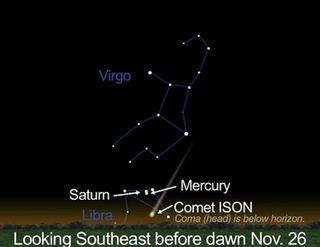
If you look to the sky early Tuesday (Nov. 26) morning, you might get a view of what can only be described as a "double planet" visible through the brightening dawn twilight.
Two bright planets — Mercury and Saturn — will get together for a rather close rendezvous, albeit quite low in the east-southeast sky that morning. Tuesday is also the last day observers can see the potentially dazzling Comet ISON before it makes its close pass of the sun on Thanksgiving Day (Nov. 28).
If we were living in the days before the invention of the telescope, this event might have been noteworthy to stargazers as a meeting between the fastest planet (Mercury) and the “highest” planet (Saturn). Saturn would have been known as the "highest" planet because it marked the outer limit of the known solar system at that point in time. [Amazing Night Sky Photos by Stargazers: November 2013]
The Romans identified Saturn with the Greek god Cronus — the allegorical name for Chronos — who was often portrayed as an old, wise man with a long, grey beard like "Father Time.” In the sky, Saturn takes nearly 30 years to make one circuit around the sky. In contrast, Mercury, the speedy messenger of the gods, darts back and forth around the sun several times within the course of a single year.
Early Tuesday morning, weather permitting, observers should see Mercury dart past Saturn.
The two planets are like two ships passing in the night. Mercury passed through its greatest elongation — its greatest angular distance west of the sun — on Nov. 17. The planet is now falling back toward the sun’s vicinity.
Meanwhile, Saturn, which has been in the sun’s immediate vicinity and out of view for the past month is now emerging back into view as a morning object, slowly moving up and away from the sun. From the perspective of skywatchers on Earth, the two planets will nearly cross paths, coming to within about a half-degree of each other — equal to the apparent width of the moon — early on Tuesday.
Get the Space.com Newsletter
Breaking space news, the latest updates on rocket launches, skywatching events and more!
Of course, in actuality they will be nowhere near each other, however, from Earth's perspective, Mercury and Saturn will be almost perfectly aligned. Mercury will be 110.4 million miles (177.7 million kilometers) away, while Saturn will be 1 billion miles (1.61 billion km) from Earth, or more than nine times Mercury’s distance from us.
The best opportunity to see these two planets will come one hour before sunrise, but again they will be very low — only about 5 degrees above the east-southeast horizon. Make sure your view in that direction is clear of any possible obstructions such as nearby trees or buildings.
Mercury will be the brighter of the two, shining at magnitude minus 0.7, some three times brighter than magnitude 0.5 Saturn. That’s because Mercury is much closer to us than Saturn, and at the moment, 82 percent of Mercury’s disk appears illuminated by the sun as seen from Earth. Saturn will be situated directly above Mercury. Use binoculars to see the two planets more clearly.
Editor's note: If you snap an amazing picture of Mercury and Saturn or any other night sky view that you'd like to share for a possible story or image gallery, send photos, comments and your name and location to managing editor Tariq Malik at spacephotos@space.com.
Joe Rao serves as an instructor and guest lecturer at New York's Hayden Planetarium. He writes about astronomy for Natural History magazine, the Farmer's Almanac and other publications, and he is also an on-camera meteorologist for News 12 Westchester, N.Y.Follow us @Spacedotcom, Facebookand Google+. Original article on SPACE.com.
Join our Space Forums to keep talking space on the latest missions, night sky and more! And if you have a news tip, correction or comment, let us know at: community@space.com.

Joe Rao is Space.com's skywatching columnist, as well as a veteran meteorologist and eclipse chaser who also serves as an instructor and guest lecturer at New York's Hayden Planetarium. He writes about astronomy for Natural History magazine, the Farmers' Almanac and other publications. Joe is an 8-time Emmy-nominated meteorologist who served the Putnam Valley region of New York for over 21 years. You can find him on Twitter and YouTube tracking lunar and solar eclipses, meteor showers and more. To find out Joe's latest project, visit him on Twitter.
